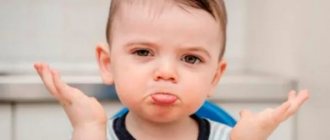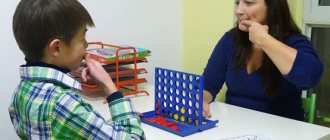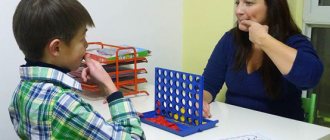A child with dysarthria cannot pronounce sounds clearly and correctly.
The cause of this condition is damage to certain parts of the brain “responsible” for correct connections with the articulatory apparatus. A severe form of dysarthria is accompanied by such obvious external manifestations that it is simply impossible not to notice it. In addition, it mainly accompanies such complex diseases as cerebral palsy, and treatment is carried out in a complex manner. Dysarthria can be of different types: cortical, bulbar, cerebellar, subcortical, depending on which part of the brain is affected. Accordingly, corrective measures will be slightly different.
Separately, I would like to note a milder form of dysarthria - it is called erased. This option may seem to parents as something insignificant that does not require deep attention. After all, Vanya’s neighbors also spoke poorly before school, but now he studies well!
You shouldn't look at Vanya and other children. Dysarthria is fundamentally different from simply not pronouncing individual sounds. Correcting this condition may require a long time and considerable effort on the part of the child and his parents.
Who treats dysarthria
To correct the situation, you need to contact two specialists - a neurologist and a speech pathologist. An accurate assessment of the condition can only be determined after a thorough examination and history taking.
Corrective measures are also carried out in two directions - neurological and speech therapy. An integrated approach includes methods such as:
- Drug therapy.
- Physiotherapy.
- Physiotherapy.
- Speech therapy classes.
Article:
Speech therapy work with children suffering from dysarthria is based on knowledge of the structure of speech defects in various forms of dysarthria , mechanisms of violation of general and speech motor skills, and taking into account personal qualities.
Positive results of speech therapy work are achieved subject to the following principles: gradual interconnected formation of all components of speech; systematic approach to the analysis of speech defects; regulation of mental activity of children through the development of communicative and generalizing functions of speech.
In the process of systematic and, in most cases, long-term training, a gradual normalization of the motor skills of the articulatory apparatus is carried out, the development of articulatory movements, the formation of the ability to voluntarily switch the movable organs of articulation from one movement to another at a given pace, to overcome monotony and disturbances in the tempo of speech; full development of phonemic perception.
Questions about the methodology of speech therapy work with children suffering from dysarthria were developed by A. G. Ippolitova, O. V. Pravdina, M. V. Ippolitova, E. M. Mastyukova, G. V. Chirkina, I. I. Panchenko and others. Let’s consider the most used system of correctional work E. M. Mastyukova and modern methods proposed by L. V. Lopatina.
E. M. Mastyukova determines the close relationship between the development of speech, sensory functions, motor skills and intelligence; determines the need for correction of speech impairments in dysarthria in children in combination with stimulation of the development of all its aspects, sensory and mental functions, thereby achieving the formation of speech as an integral mental activity.
The success of speech therapy classes largely depends on their early start and systematic implementation.
Work on sound pronunciation is based on the following provisions:
- dependence on the form of dysarthria , level of speech development and age of the child;
- development of speech communication - the formation of sound pronunciation should be aimed at the development of communications, school and social adaptation of the child;
- development of motivation - the desire to overcome existing violations, the development of self-awareness, self-confidence;
— development of differentiated auditory attention and sound analysis;
- strengthening the perception of articulatory patterns and movements through the development of visual-kinesthetic sensations;
- step-by-step - start with those sounds whose articulation is more intact in the child. Sometimes sounds are chosen on the basis of simpler motor coordination, but always taking into account the structure of the articulatory defect as a whole; first of all, they work on the sounds of early ontogenesis;
— in case of severe disorders, when speech is completely incomprehensible to others, work begins with isolated sounds and syllables . If the child’s speech is relatively clear, and in individual words he can pronounce defective sounds correctly, the work begins with these “key” words. In all cases, automation of sounds is necessary in all contexts and in various speech situations;
— in children with damage to the central nervous system, it is important to prevent severe disorders of sound pronunciation through systematic speech therapy work in the pre-speech period .
Speech therapy work for dysarthria is carried out in stages.
The first stage is preparatory, its main tasks are:
— preparation of the articulatory apparatus and formation of articulatory structures;
— nurturing the need for verbal communication;
— development and refinement of passive vocabulary;
- development of sensory functions, especially phonemic perception and rhythm reproduction.
Methods and methods of work at this stage are differentiated depending on the level of speech development. In the absence of verbal means of communication, initial vocal reactions are stimulated in the child and induce onomatopoeia, which is given a character of communicative significance.
Speech therapy work is carried out against the background of medication, physiotherapy, physical therapy and massage.
The second stage is the formation of primary communicative pronunciation skills. Its main goal is the development of speech communication and sound analysis.
Corrective work at this stage is carried out in the following areas:
1. Normalization of the innervation of the articulatory apparatus.
2. Fight against salivation.
3. Developing control over mouth position.
4. Development of articulatory movements and voice.
5. Correction of speech breathing.
6. Development of sensations of articulatory movements and articulatory praxis.
Normalization of the innervation of the articulatory apparatus is carried out using massage. Work on relaxing the muscles of the articulatory apparatus begins with general muscle relaxation, relaxation of the cervical, chest muscles, and facial muscles. A relaxing massage is carried out in doses.
Developing control over mouth position.
Lack of control over mouth position in children with dysarthria significantly complicates the development of voluntary articulatory movements.
The first stage of work is exercises for the lips, helping to relax them and enhance tactile sensations in combination with passive closing of the child’s mouth.
At the second stage, the mouth is closed in a passive-active way. At first, it is easier for a child to close his mouth when his head is tilted, and easier to open when his head is slightly tilted back.
At the third stage, active opening and closing of the mouth is trained according to verbal instructions.
Articulation gymnastics.
At the initial stages, work is carried out with the maximum connection of other, more secure analyzers. Articulatory gymnastics is differentiated depending on the form of dysarthria and the severity of damage to the articulatory apparatus. The development of articulatory motor skills is carried out systematically, over a long period of time, using a general complex and specific exercises.
Voice development.
For the development and correction of voice in dysarthric , various orthophonic exercises are used, aimed at developing the coordinated activity of breathing, phonation and articulation. Activation of the movements of the soft palate and jaws is of great importance for voice correction.
Correction of speech breathing.
Breathing exercises begin with general breathing exercises. The goal is to increase breathing volume and normalize its rhythm. Breathing exercises are carried out before meals, in a well-ventilated area. The child is taught to breathe with his mouth closed, and exercises are carried out to train nasal exhalation.
Development of sensations of articulatory movements and articulatory praxis.
For the development of articulatory praxis, early speech therapy work , expansion and enrichment of the child’s speech experience, as well as the predominance of special speech exercises over purely articulatory ones are of great importance.
Correction of sound pronunciation.
The principle of an individual approach is used. The method of sound production and correction is selected individually. If the pronunciation of several sounds is impaired, consistency in work . Before calling and staging sounds, it is important to distinguish them by ear. By modeling this or that articulatory structure for the child, the speech therapist stimulates the evocation of an isolated sound, then automates it in syllables, words and in contextual speech.
There are several techniques for producing sounds for dysarthria . The most common method is the so-called phonemic localization. The main methods of work are : motor-kinesthetic and auditory-visual-kinesthetic.
When developing sound pronunciation skills, a speech therapist works to automate and differentiate sounds and develop pronunciation skills in various communication situations. Sounds are fixed in words and sentences.
For automation, the technique of simultaneous pronunciation of a sound and the image of its symbol is used - writing and speaking.
For children who cannot write, the sound is made at the same time as finger tapping or foot tapping. The new sound is then fixed in various syllables. Gradually move from simple exercises to more complex ones, speeding up the pace of exercises.
When working on sound, it is important to identify the child’s intact compensatory capabilities.
Correction of the sound pronunciation aspect of speech is combined with work on its expressiveness.
The work is carried out by imitation. The content and methods of work vary depending on the nature and severity of dysarthria , and the general level of speech development.
In all cases, the main task of speech therapy work for dysarthria is the development and facilitation of speech communication, and not just the formation of the correct pronunciation of sounds.
Lopatina L.V., in the process of speech therapy work to overcome phonetic-phonemic disorders in preschoolers with erased dysarthria , determines the following tasks:
-formation of psychophysiological mechanisms that ensure mastery of the phonetic side of speech (sensory and motor parts of the speech process);
- formation of speech skills of phonetically correct speech, intonation expressiveness.
In the process of speech therapy work, the implementation of these tasks is carried out in their unity and interconnection.
The system for overcoming phonetic-phonemic disorders includes the following sections:
1. development of manual motor skills and motor skills of the articulatory apparatus;
2. formation of correct articulation of sounds and automaticity of their pronunciation in various phonetic conditions;
3. formation of intonation expressiveness of speech;
4. formation of perception of oral speech.
I. Development of manual motor skills and motor skills of the articulatory apparatus.
Work within this area is based on the following provisions:
-level organization of movements, which allows one to decompose a complex motor act into its component components and identify the state of the cerebral levels, their role in the regulation of movements and action;
- the relationship between fine differentiated motor skills of the hands and articulatory motor skills. With normal development, the child masters the sound side of speech simultaneously with the development of general motor skills and differentiated hand movements. Systematic exercises that train finger movements, along with a stimulating effect on speech development, are a powerful means of increasing the performance of the cerebral cortex;
- complex interaction of the kinesthetic and kinetic basis of movements. To carry out a motor act, the presence of two components is necessary: a kinesthetic basis, which provides a differentiated composition of complex movements, and a kinetic structure, which underlies the formation of smooth motor skills that occur over time (A. R. Luria). The kinetic program is ensured by the participation of its brain mechanism for creating a kinesthetic scheme of voluntary movement;
- provisions on the role of kinesthesia in movement control. Voluntary movements and actions require constant comparison of the planned act with the one actually reproduced. Continuous feedback signals must be received from the movement being performed, constituting the content of reverse differentiation and constantly being compared with the planned action.
Work on the development of manual and articulatory motor skills is carried out in two directions.
1. Formation of the kinesthetic basis of movement.
The main objectives of this area of speech therapy work are :
-organization of motor impulses directed to certain muscle groups and clarification of the composition of the motor act;
-development of kinesthetic analysis and synthesis of kinesthetic afferentations of manual and articulatory movements.
In the process of forming the kinesthetic basis of hand movements, the hands and fingers are given different positions, which the child reproduces with his eyes closed (or behind the screen). When forming the kinesthetic basis of articulatory movements for the development of motor-kinesthetic feedback, special exercises are carried out aimed at clarifying the position of the articulatory organs during the pronunciation of correctly pronounced sounds. When performing them, children's attention is constantly drawn to the kinesthetic sensations that arise. Initially, these exercises are based on visual images of movement, which are then eliminated.
2. Formation of the kinetic basis of movement.
The main objectives of the second direction of speech therapy work are :
- unification, generalization of successive impulses into a single, time-organized motor stereotype, transforming individual motor skills into smooth, serially organized ones;
-development of static and dynamic coordination of movements.
In the process of forming the kinetic basis of hand movements, exercises are carried out aimed at developing a system of movements consisting of “main” and “background” components (according to A. N. Bershtein) or a series of similar movements that make up a single motor skill.
The development of dynamic coordination of hand movements is carried out in the process of performing both sequential and simultaneously organized movements.
In the process of forming the kinetic basis of articulatory movements, the main attention is paid to exercises aimed at developing the necessary range of movements, mobility of the organs of the articulatory apparatus, strength, accuracy of movements, and developing the ability to hold the articulatory organs in a given position.
Work on the formation of the kinesthetic and kinetic foundations of manual and articulatory movements will be carried out simultaneously.
II. Formation of correct articulation of sounds and automaticity of their pronunciation in various phonetic conditions.
After the formation of the correct articulatory pattern of sound in the process of performing articulatory exercises, the automaticity of its pronunciation in various phonetic conditions is developed. The implementation of automatic pronunciation of a newly formed sound in all variants of defective pronunciation is recommended to begin with the structure of the syllables GS (vowel - consonant, and then SG (consonant - vowel). This sequence of work is due to the fact that in the structure of a syllable of the SG type, the sounds that make it up are articulatory- acoustic characteristics are fused with each other in such a way that they can more fully contain all phases of articulation.
Automation of sound in combination with any vowel is carried out from syllables to words , and then to sentences in order to quickly and more naturally introduce the sound in a given syllable structure into contexts of varying complexity. After achieving automaticity in the pronunciation of a sound alternately with various vowels in the structure of a syllable of the GS type, the sound is also automated in speech material, including the structure of the SG syllable.
III. Formation of intonation expressiveness of speech.
Since the phonetic side of speech is a close interaction of its main components (sound pronunciation and prosody) and since children with erased dysarthria have violations of a number of prosodic elements of speech, in the process of speech therapy work is done to form intonational expressiveness of speech.
This work is preceded by exercises. They prepare children to perceive intonation expressiveness, contribute to its development, and create the prerequisites for mastering logical stress and correct division of phrases.
Work on rhythm is carried out in two directions: perception and reproduction of various rhythmic structures.
Speech therapy work on the formation of intonation expressiveness of speech is carried out in stages.
Stage 1. Formation of ideas about intonational expressiveness in impressive speech.
The tasks of this stage include:
- show children that human speech has a variety of intonations, which is achieved by changing the pitch, strength, timbre, and modulation of the voice, that intonation gives color to speech and helps express feelings;
-introduce children to various types of intonation and means of indicating them, as well as teach them to distinguish between various intonation structures in impressive speech
In accordance with the identified tasks, work is carried out in five directions:
1) the formation of general ideas about the intonational expressiveness of speech. The speech therapist reads the same story twice. The first time without intonation of the text, the second - expressively. The speech therapist explains to children that the voice can be changed when reading, that the voice can convey questions, joy, threats, etc.
2) familiarity with narrative intonation, the means of its expression and methods of designation. The speech therapist pronounces a sentence with a narrative intonation and invites the children to determine what this sentence expresses.
3) differentiation of intonation structures of sentences in expressive speech. This work is carried out on the material of rhymes, dialogues , and fairy tales. Children must learn to imitate voices.
IV. Formation of perception of oral speech.
Speech therapy work to overcome phonemic disorders in preschoolers with erased dysarthria is carried out taking into account the following provisions:
- modern ideas about the multi-level structure of the speech perception process (N. I. Zhinkin, I. A. Zimnyaya, E. I. Vinarskaya);
- provisions on the relationship between elementary and higher mental functions in the process of child development;
-scientific data on the stages of development of phonemic functions in ontogenesis.
When developing this technique, some techniques and methods described in the works of V. . K. Orfinskaya, D. B. Elkonina, E. F. Sobotovich, R. I. Lalaeva.
Work to overcome phonemic disorders is carried out in stages.
Stage 1. Formation of perception of oral speech at the phonetic level.
The objectives of this stage are:
-development of speech sound recognition;
-development of the stimulating function of the speech-hearing analyzer;
-formation of auditory control over the quality of one’s own pronunciation;
-creation of favorable conditions for the subsequent formation of phonemic functions.
Work at this stage is carried out in two directions.
1) Formation of perception of oral speech in the process of imitation of syllables .
2) Formation of perception of oral speech in the process of distinguishing correctly and distortedly pronounced sounds.
- recognition of distorted pronunciation, different from one’s own, in someone else’s speech;
- recognition of distorted pronunciation similar to one’s own in someone else’s speech.
The development of auditory control is carried out simultaneously with the formation of the correct articulatory structure of sound, using visual perception of tactile and kinesthetic sensations.
Stage 2. Formation of perception of oral speech at the phonological level.
Due to the fact that clear phonemic ideas about the sound composition of the language contribute to the improvement of correct sound pronunciation, the task of this stage includes the development of the functions of the phonemic system.
The formation of phonemic functions is carried out in two directions: the development of phonemic perception (differentiation of phonemes) and the development of phonemic analysis and synthesis.
Work at this stage begins with consistent clarification of the pronunciation and auditory images of the sound being practiced and is carried out in three directions.
1) Clarification of sound articulation based on visual, auditory, tactile perception, and kinesthetic sensations.
When clarifying the correct articulation of a sound, attention is paid to the work of the articulatory organs when pronouncing it. To consolidate the visual image of sound, children are offered symbolic images.
2) Isolation of sound against the background of a syllable.
Children are offered a number of syllables from which they need to select a given sound. Syllables should not contain oppositional sounds.
3) Isolation of sound against the background of a word.
This work is carried out on the material of words containing this sound and not having it. Words with similar acoustic sounds and sounds that are mixed in pronunciation are excluded.
Thus, dysarthria requires early , long-term and systematic speech therapy work . Its success largely depends on the relationship in the work of a speech therapist and a neurologist or neuropsychiatrist, a speech therapist and parents , and in case of obvious motor disorders - a speech therapist and a massage therapist , a specialist in physical therapy.
The work of a speech therapist-defectologist for dysarthria
In this case, the speech pathologist-defectologist takes on the responsible role of correcting existing disorders in the child’s speech. It is very important that parents understand the need for regular classes and mandatory homework.
With the right approach, the prognosis for the erased form of dysarthria is the most favorable. The child is fully capable of mastering correct speech and will be able to successfully study at school.
What is included in the classes:
- Articulation gymnastics. It is necessary in order to “teach” the tongue to take the correct place when pronouncing a particular sound.
- Exercises to develop correct speech breathing.
- Development of fine motor skills. It is widely known that the better the coordination of the fingers, the faster correct speech is formed.
- Formation of spatial orientation.
- Speech therapy tongue massage. Even due to minor brain damage, many children have disturbances in the tone of the articulatory apparatus. A special massage helps relieve excess tone or, conversely, strengthen the necessary muscles.
- Establishing the correct pronunciation of sounds.
Problems will certainly go away
The work of a speech therapist for dysarthria is aimed at restoring the softness of speech. The articulation apparatus is warmed up through special exercises. Massage is included in the treatment. As the patient regains the ability to speak, the doctor begins to work on speech clarity.
Individual speech therapy sessions for dysarthria include massage, psychological consultations, physical therapy, including exercises to restore movements. The specialists of our Center are able to awaken interest in classes even in those children who initially do not perceive speech therapy classes as something attractive, so the results are not long in coming. At the same time, treatment with medications is carried out.
Only through the interaction of the child himself, his parents and several medical specialists can one count on a quick and effective result.






